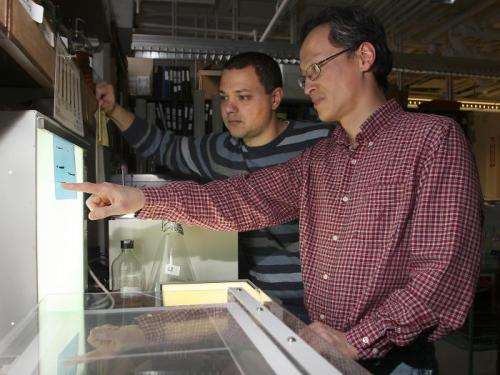Yeast study yields potential for new cholesterol, anti-fungal drugs

(Phys.org)—While studying a mutant strain of yeast, Purdue University researchers may have found a new target for drugs to combat cholesterol and fungal diseases.
Scott Briggs, an associate professor of biochemistry, and Paul South, a postdoctoral researcher, were looking at how histones, the proteins that DNA wraps itself around, are affected by environmental factors, a field called epigenetics. When histones are modified, they change how genes are expressed and how cells behave.
One of the research team's yeast mutants lacks a methyltransferase called Set1, which is a protein that modifies histones. In this case, the lack of the methyltransferase decreases the amount of ergosterol production. Ergosterol is the equivalent of human cholesterol, and the biological pathways that create ergosterol in yeast and cholesterol in humans are similar, with both being essential for cellular membrane formation and integrity.
"So, if we could actually design an inhibitor to this methyltransferase, we potentially could have another drug to lower cellular cholesterol or one that could work in conjunction with current cholesterol-lowering drugs," said Briggs, whose findings were published in the Proceedings of the National Academy of Sciences.
The same yeast mutant with decreased ergosterol production was particularly sensitive to an anti-fungal metabolite called Brefeldin A, a drug primarily used as a research tool to study protein transport in cells.
"If you don't have this methyltransferase, cells grow slower in the presence of this anti-fungal metabolite," South said. "That means that a drug that inhibits the methyltransferase could also be used as an anti-fungal drug and potentially be used as another tool to fight drug-resistant fungal infections."
Development of new anti-fungal drugs could help with difficult-to-treat fungal infections, such as the fungal meningitis outbreak last year from contaminated drugs linked with a Massachusetts compounding pharmacy.
Briggs and South are now studying whether the yeast mutant that is more sensitive to Brefeldin A would be more susceptible to other clinically relevant anti-fungal drugs.
More information: H3K4 Methyltransferase Set1 is Involved in Maintenance of Ergosterol Homeostasis and Resistance to Brefeldin A, Paul F. South, Kayla M. Harmeyer, Nina D. Serratore, and Scott D. Briggs, PNAS, 2013.
ABSTRACT
Set1 is a conserved histone H3 lysine 4 (H3K4) methyltransferase that exists as a multisubunit complex. Although H3K4 methylation is located on many actively transcribed genes, few studies have established a direct connection showing that loss of Set1 and H3K4 methylation results in a phenotype caused by disruption of gene expression. In this study, we determined that cells lacking Set1 or Set1 complex members that disrupt H3K4 methylation have a growth defect when grown in the presence of the anti-fungal drug Brefeldin A (BFA), indicating that H3K4 methylation is needed for BFA resistance. To determine the role of Set1 in BFA resistance, we discovered that Set1 is important for the expression of genes in the ergosterol biosynthetic pathway, including the rate-limiting enzyme HMG-CoA reductase. Consequently, deletion of SET1 leads to a reduction in HMG-CoA reductase protein and total cellular ergosterol. In addition, the lack of Set1 results in an increase in the expression of DAN1 and PDR11, two genes involved in ergosterol uptake. The increase in expression of uptake genes in set1Δ cells allows sterols such as cholesterol and ergosterol to be actively taken up under aerobic conditions. Interestingly, when grown in the presence of ergosterol set1Δ cells become resistant to BFA, indicating that proper ergosterol levels are needed for anti-fungal drug resistance. These data show that H3K4 methylation impacts gene expression and output of a biologically and medically relevant pathway and determines why cells lacking H3K4 methylation have anti-fungal drug sensitivity.
Journal information: Proceedings of the National Academy of Sciences
Provided by Purdue University



















